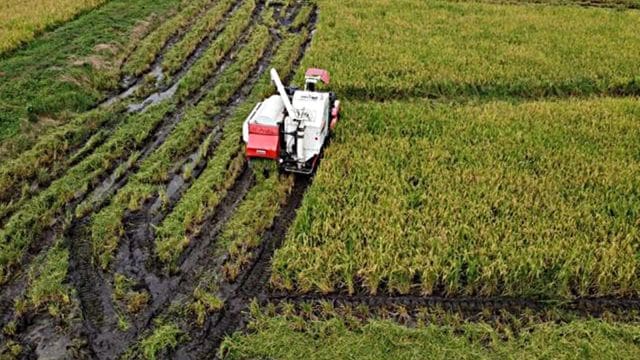Maize: A double-edged sword for Punjab’s groundwater crisis
1.90L ha under water guzzler spring maize raises experts' concerns: 'Opt for hybrid kharif maize'
 A surge in spring maize cultivation is causing increasing concern among water experts (Reuters)
A surge in spring maize cultivation is causing increasing concern among water experts (Reuters)Maize has become a double-edged sword for Punjab, simultaneously acting as a boon and a bane in a state grappling with groundwater depletion.
The crop is sown in two contrasting seasons — the water-intensive spring/summer season (February to June) and the more water-conservative kharif season (June to October), running parallel to the paddy harvest — highlighting a growing dilemma as to how to balance the benefits of this crop with the critical need to conserve water resources.
According to the preliminary reports of private companies selling maize seeds in Punjab and Punjab Agricultural University (PAU) officials, the area under spring maize has increased to 1.80-1.90 lakh hectares this year from around 1.50 lakh hectares last year and nearly 30,000 to 35,000 hectares a decade ago.
This is an exponential growth in the area under spring/summer maize over a decade, even though the Punjab Revenue Department does not officially track spring maize sowing because it is not considered part of the primary kharif crop cycle.
“Nearly 3,500 to 3,800 metric tonnes of spring maize seeds were sold in the state this season. As 8 kg of seeds are required for one acre, meaning Punjab has brought around 4.50 to 5 lakh acres under this crop,” Federation of Seed Industry of India chairman Ajai Rana said, quoting market sources.
Spring/summer maize: a water guzzler
However, a surge in spring maize cultivation is causing increasing concern among water experts.
Depending on soil type and irrigation methods, spring maize requires 5 to 19 irrigations, a major burden on Punjab’s depleted groundwater table. The short-duration paddy varieties need around 20 to 21 irrigations, close to spring maize crops.
Amritpal Singh Randhawa, who grows spring maize on 42 acres at Phuglana village in Hoshiarpur district, said, “If maize is sown in the first fortnight of February, when the weather is cooler, it consumes less water. Our soil is moist and has a heavy texture due to water retention, and we need only five irrigations until the end of June. After that, I do not grow paddy but cultivate vegetables. This way, I save water. However, when farmers sow maize in sandy or light-textured soils, it requires multiple irrigation cycles. And, if they then go for paddy, it puts a huge strain on groundwater. Thus, the water consumption by maize depends on several factors.”
Randhawa added, “In our village, around 70 per cent of farmers grow maize because the soil is suitable. After that, most of these farmers cultivate vegetables, not paddy crops. As a result, there is no significant depletion of groundwater. It is available at 26 to 30 feet deep in our area.”
But this is not the situation everywhere spring maize is grown.
Farmer Parampreet Singh of Nakodar in Jalandhar, too, grows spring maize, after harvesting potato, on around 100 acres, and it needs around 15-16 irrigations. “I sow it by mid-March after harvesting potatoes. After maize, I grow paddy.”
Asked about the stress on groundwater after taking two water-intensive crops in a row, Parampreet Singh said, “I need to bore tube-well after every 2-3 years deeper than 100 feet.”
According to experts, farmers who grow spring maize follow 12 to 19 irrigation cycles.
“Spring maize takes a significant toll on the groundwater reserve, particularly as its peak irrigation period coincides with the hottest months, April to June. PAU experts have long discouraged farmers from sowing spring maize for this reason, warning its expansion is unsustainable,” said Gurdaspur Chief Agriculture Officer Dr Amrik Singh, adding that due to the high evaporation rate from extended sunshine hours during these months, frequent watering of the crop is required.
Kharif maize: a much-needed alternative
In contrast, kharif maize, sown alongside paddy during monsoon and harvested in late October to November, is considered an excellent alternative to water-intensive paddy and the Punjab government promotes it extensively.
Kharif maize is less water-intensive due to the monsoon season and needs just three to four irrigations throughout the season, making it one of the best crops to reduce Punjab’s reliance on groundwater.
Despite its potential, the area under kharif maize has declined in recent years — 1.05 lakh hectares to 1.30 lakh hectares for over a decade to just around 80,000 hectares in 2024 — far below than 5.5 lakh hectares under the maize cultivation suggested by experts, including PAU scientists, as part of the state’s crop diversification strategy.
Why spring maize is gaining ground and area under kharif maize decreasing
The answer lies in the economics of maize cultivation. Maize, particularly in the kharif season, yields significantly less than paddy — about 20 to 22 quintals (dry) per acre compared to 30 and above quintals per hectare of paddy. Additionally, maize does not enjoy the government procurement support as does paddy.
Despite heavy irrigation requirements, spring maize is gaining ground among farmers due to higher yields. For example, spring maize can produce 39 to 40 quintals (after drying) per acre — almost double the yield of kharif maize, which only produces about 20 to 22 quintals per acre — promising better return, enticing farmers to increase area at the cost of groundwater, even as around 80 per cent of the state’s agricultural blocks has been classified as “dark and critical zones” where the groundwater table is overexploited.
According to the Central Ground Water Board (CGWB), the state could run out of groundwater in just two decades if the current trends continue.
What needs to change
Hanuman Sahay Jat, Director of the Indian Institute of Maize Research (IIMR) at PAU, Ludhiana, told The Indian Express, “Kharif maize offers a sustainable solution to the groundwater crisis. The growing popularity of spring maize is causing groundwater depletion. Hybrid seeds for kharif maize now yield results comparable to paddy. Punjab must develop its high-quality seeds for successful maize diversification.”
Jat noted that IIMR can provide vital technical expertise, as farmers rely on costly private seeds or those from Andhra Pradesh and Telangana. He also emphasised the need for a proper minimum support price (MSP) and infrastructure, like dryers, to support maize cultivation.
While Punjab has substantial demand for maize, it doesn’t meet even 10 per cent of it.
Jat warned that removing free power subsidies could lead farmers to shift to kharif maize but also cautioned against spring maize due to its impact on groundwater.











